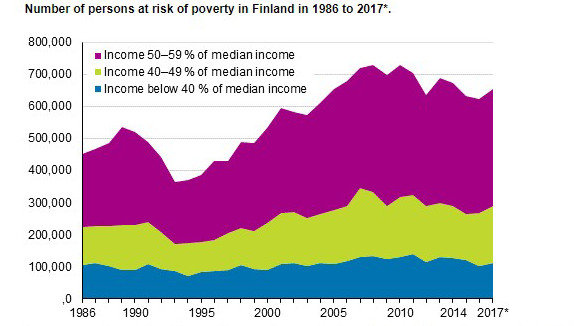The risk of falling into poverty in Finland is real for more people than one year before. At least this is what comes out of the figures from the income distribution statistics published today by the Finnish statistical office.
The figures indicate that the amount of persons who belong to households at risk of poverty was 654,000 in 2017, this is 31.000 more in year-on-year comparison.
Now the share of persons at risk of suffering poverty in the household population is 12.1%. This percentage is 0.6 points higher than in the previous year. Then the number of persons belonging to households at risk of poverty was 623.000.

Source: Statistics Finland
Statistics Finland remarks that the relative risk of poverty has varied in the past ten years between 623,000 and 728,000 persons, when the used at-risk-of-poverty threshold is 60 per cent of median income. In 2017, the at-risk-of-poverty threshold was 14,750 euros per year for one-person households, that is, around 1,230 euros per month.
At-risk-of-poverty indicator describes the relative income differentials of medium-income and low-income groups. Therefore, the development of the number of persons at risk of poverty depends also on the development of median income, not only on the income development of low-income households.
Persons are classified as being at-risk-of-poverty when the household's disposable monetary income per consumption unit (one adult) is below 60 per cent of the national median income. Households’ median income from which the at-risk-of-poverty threshold is counted, was 24,580 euros for a one-person household in 2017.
Difficulties in making ends meet decreased
Despite the increase in the risk of suffering poverty derived from income differences, the Finnish statistical office has published also figures that show that the number of households experiencing at least some difficulties in making ends meet decreased by 60.000. According to those numbers, during the year 2017 a total of 605,000 households (22.3% of all), experienced at least some difficulties in making ends meet.
The number of households experiencing more serious difficulties went down and was 189,000 (7% of all). One year earlier, the number of households experiencing more serious difficulties in making ends meet was 198,000, that is 7.4 per cent of all households.
The share of households experiencing difficulties has varied between seven and eight per cent after 2010. However, the share in 2017 was the smallest one in the measurement period starting in 2003.
The consumption units are based on the so-called OECD modified scale. One adult in the household is one consumption unit. Other persons in the household aged at least 14 each are 0.5 consumption units and children aged 0 to 13 each are 0.3 consumption units. So, for calculation purposes a household with one adult member is one consumption unit, while a household consisting of spouses and one child aged under 14 together are 1.8 consumption units.











